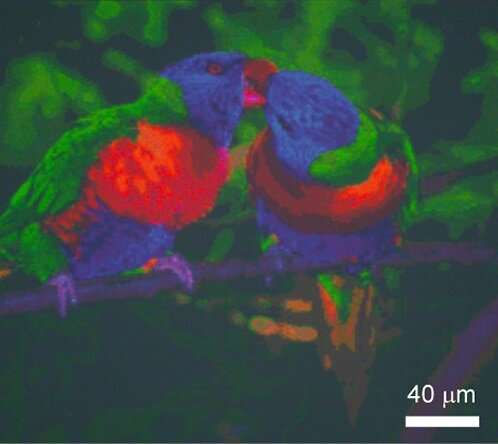An image of two colorful parrots was created by mixing red, blue and green structural colors. Credit: Adapted from ACS Nano 2020, DOI: 10.1021/acsnano.9b07523
By blending paints in their palette, artists can create a broad spectrum of colors with subtly different hues. However, scientists who wish to create a similar range of structural colors, like those found on butterfly wings, are much more limited. Now, researchers reporting in ACS Nano have developed a new method for mixing plasmonic red, blue and green to yield a virtually unlimited number of colors that could be used for new types of displays.
Unlike pigments, structural colors get their hues by reflecting light from microscopic textures. Scientists can create some of these colors by putting metal nanoparticles onto surfaces in various patterns. These "plasmonically induced" colors are less susceptible to fading than pigments, and they might be useful for new types of paint, electronic displays and anti-counterfeiting measures. But producing a gamut of structural colors with smooth transitions between hues and tones has been challenging. Therefore, Dimos Poulikakos, Hadi Eghlidi and colleagues wanted to develop a new plasmonic color-mixing approach that would allow countless color variations.
The researchers began with a palette of three primary colors (red, green and blue). They made pixels of each color by arranging silver nanorods in lattice patterns on glass surfaces. The lengths and widths of the nanorods, and the distances between nanorods in the horizontal direction, determined whether the pixel was red, green or blue. The researchers adjusted the brightness of each color by varying the vertical distance between nanorods in the lattice. When the team interwove three of the primary color lattices in a single pixel and varied the vertical distances to adjust brightness, they could generate 2,456 unique colors with a pixel size of 4.26 × 4.26 μm. The researchers demonstrate the method to reproduce an image of two colorful parrots and a black-and-white photograph of Marie Curie.
More information: Claudio U. Hail et al, A Plasmonic Painter's Method of Color Mixing for a Continuous Red–Green–Blue Palette, ACS Nano (2020). DOI: 10.1021/acsnano.9b07523
Journal information: ACS Nano
Provided by American Chemical Society
























